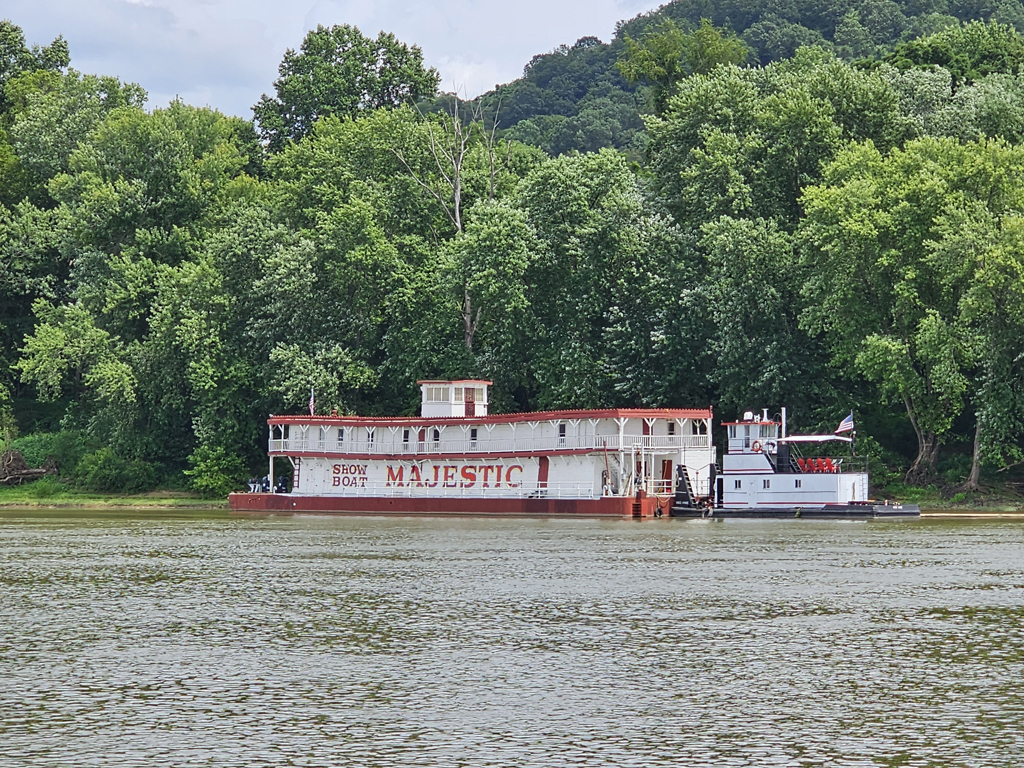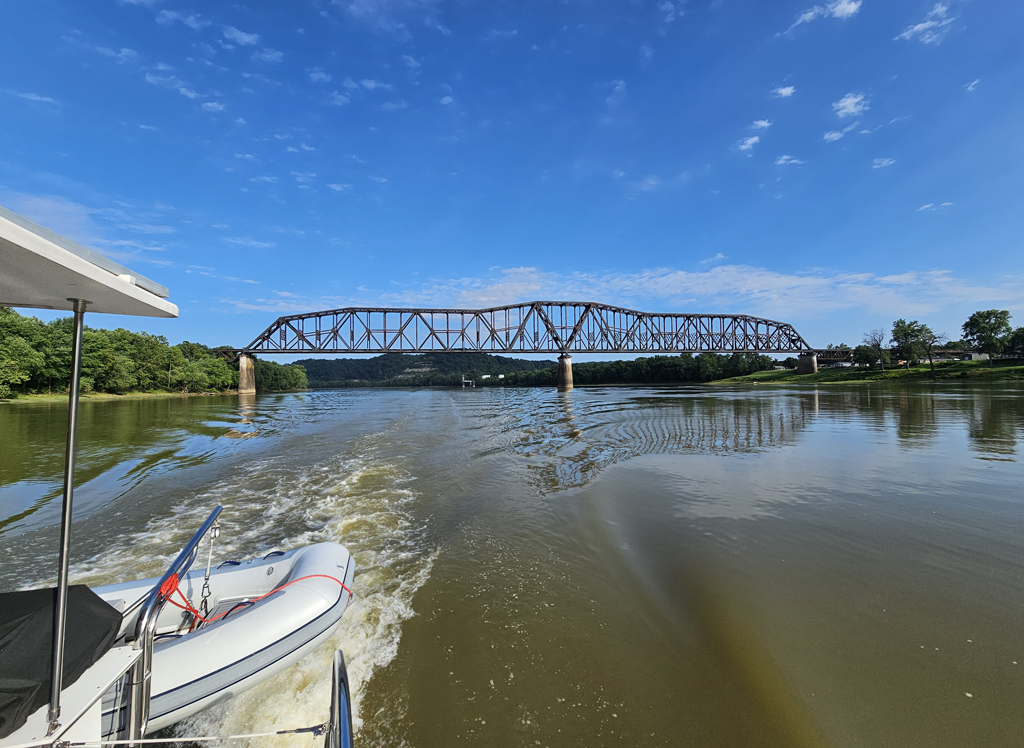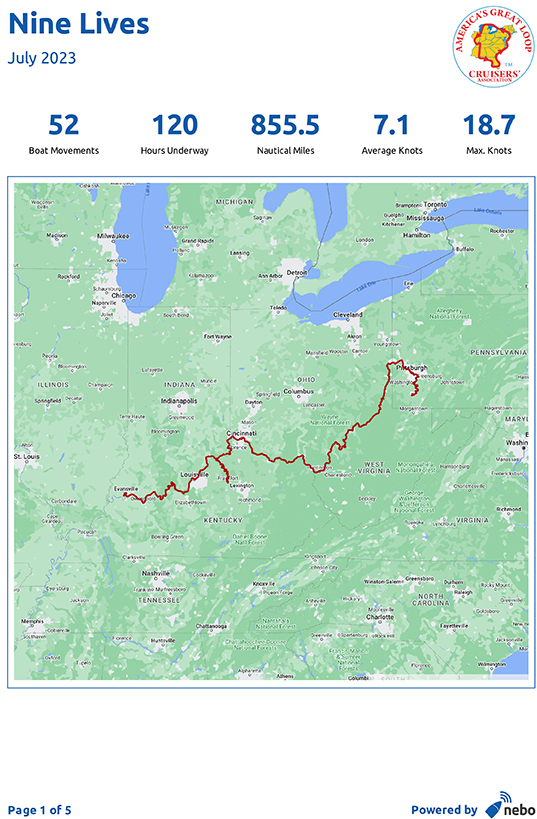On our last evening in Morgantown we walked to the very nearby Marriott Hotel for dinner at the Bourbon Prime Restaurant. We were pleasantly surprised at how good the food was, as so many hotel restaurants are not up to expectations or the prices charged. Pepperoni rolls were a particular highlight. They are small rolls with pepperoni sausage baked in, topped with parmesan and served with marinara sauce. These were described as a West Virginia specialty. Dick had the prime rib special, and I liked their prime rib sandwich. The chocolate espresso dessert was most unusual and delicious.




We were away by 9am on the 4th. Although we had stayed for 3 nights, there was no charge by the city for dockage. In subsequent conversations with other boaters, we learned that the city has essentially abandoned the idea of a properly serviced marina, and the power posts have been disabled and water cut off. Interestingly, there is a sign that advises that additional transient dockage is available just downriver at the city park, however, anyone who tries to stay there for more than one night is moved on by local police.
One of the lock keepers told Dick that this is a good time to be transiting the Monongahela River, as most of the businesses that support the barge traffic are on their summer break. Normally there would be 10-12 tows a day going through the locks, with commensurate delays for pleasure boaters like us.
We were amazed at the huge coal pile at the Fort Martin Power Station. 150 deaths a year are attributed to the fine particles emitted from this plant, in addition to several thousand hospitalizations and illnesses. Gas-fired generating plants produce only 1/10 of the pollutants from coal plants. For the sake of comparison, West Virginia has 175 deaths per year from drunk driving. Much attention is paid to this second statistic, and yet the average person does not seem to have much awareness of the dangers from polluted air and water, in spite of many years of campaigning by concerned organizations. As Dick pointed out, deaths from drunk driving are individual, and usually fairly obvious to pinpoint cause and effect, whereas deaths from air and/or water pollution are less certain. Also, big business has deep pockets and many lawyers, while the average Joe does not.

Our performance at Point Marion Lock was our worst in quite a while. I miscalculated, and brought Nine Lives too close to the wall too early, so she bounced gently but determinedly off the wall with the fenders. I tried to correct, but then we were too far away from the floating bollard and Dick dropped the line. I had to back up and start again. The next lock went fine and was up to our usual professional standard!

We tied up at Jessop Boat Club. Our first attempt to get into the suggested slip had to be abandoned, as the finger piers were too short for us to be able to get off the boat. Dick turned around and started to back in, but then the helpful dockmaster said that the end dock is longer and would work better for us. Since there was no power at either location, we went for the longer dock. We hoped for a long enough hose to get to the water tap, as we had been 3 days without, and there would not be any the next day. We can go 4, perhaps 5 days without filling the tank, but to do so requires careful management, including navy showers. A navy shower is when you save water by turning off the tap except for an initial wetting down and subsequent rinsing. From my point of view, it takes away all the enjoyment of the shower, plus missing any health benefits of the warm/hot water increasing blood flow.
Dick was able to borrow a long enough hose, and with much to-ing and fro-ing back and forth along the docks, he got the water going. Nine Lives was able to get a nice wash down to get rid of mud from lock walls and the evidence of an incontinent bird, plus having the water tanks filled.
In the evening we walked up to the onsite restaurant. The food was quite good of its kind (baskets, burgers, chicken wings). The Boat Club is a popular gathering spot, with over 600 members. We met one or two people and enjoyed chatting. A recently installed water slide has proved very popular with members, allowing the children to be well occupied while the adults socialize.
The next morning, as he was making the coffee, Dick noticed that he was feeling a bit of a draft. He discovered that his venerable Tilley shorts had a tear over 8” long. Sparing his blushes, I did not try to photograph the wardrobe malfunction. Like, many men, Dick prefers to keep comfortable clothes, no matter how well-worn or faded they may be, until disaster strikes!


Along the river, we passed a beautifully landscaped home on the waterfront. Interestingly, all the terracing is accomplished with old tires. A laudable effort at recycling, but we can’t help but wonder about chemicals leaching into the soil, and of course the river, as the tires age and the rubber deteriorates.

We also passed a plant that constructs new barges. There was one just completed, waiting on the rails to be slid down into the river. Chip tells us that they only launch on certain weekdays, so we did not have the opportunity to see one launched, it would have been fascinating!

We tied up on the wall at Monongahela Aquatorium. It was a very rough wall, with a part sticking out at the top about 15 inches, so mooring required careful use of lots of fenders. Two other large boats chose the low floating docks, but we felt the wall was a better bet for Nine Lives. It was a busy afternoon as boats gathered for the evening concert. Some anchored, some just drifted on the river, and a few rafted up once the wall and the floating docks were filled up. Rafting up means that after one boat is either anchored or tied up to a dock or wall, another boat will come alongside, and with lots of fenders on both boats, they tie to each other. Depending on the size of the boat and whether or not the first is well anchored or tied to a dock or wall, there can be three or four together. Everything depends on the first boat, and given what we have observed of the practices of our fellow boaters, we always prefer to be that first boat, the one that others raft to. As it happened, on this occasion, nobody asked us, and we decided not to offer.

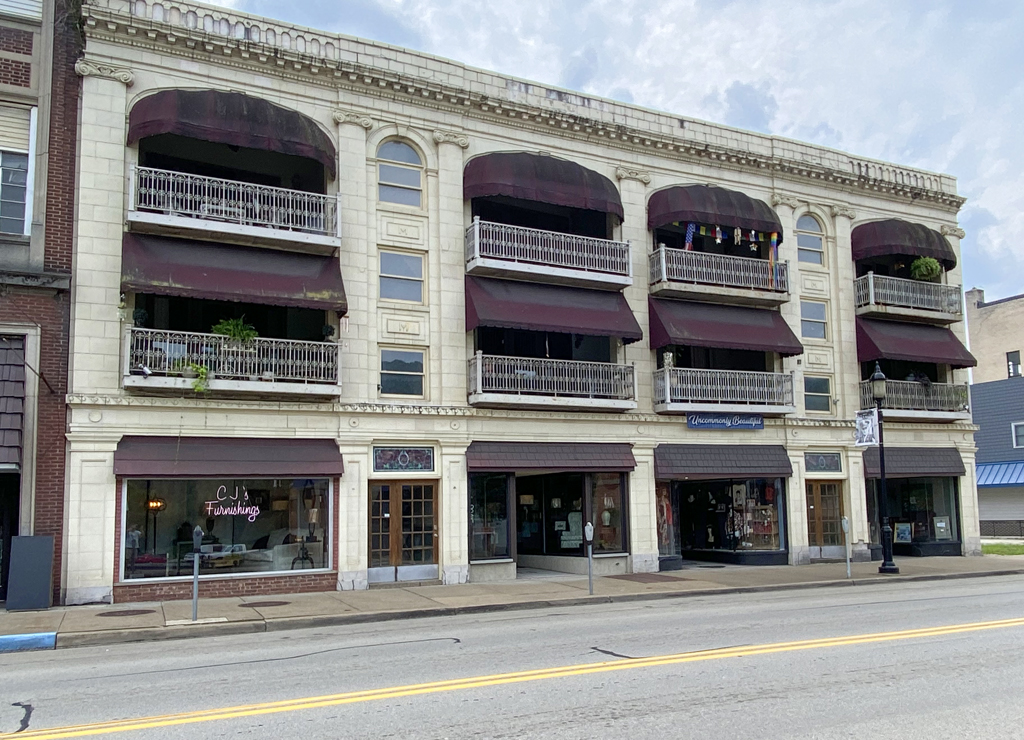
By late afternoon, Dick joined me in the cockpit (bringing adult beverages), and was able to see what I find so fascinating when we are stopped in a busy spot while he sits below with his computer. It never ceases to amaze me how unprepared people are, especially in smaller boats. No lines ready, fenders put away in lockers, or hanging on the wrong side of the boat, and usually nobody with a clear idea of what needs doing except the captain, who is busy driving the boat and then jumps around trying to do everything else as well. Some of the antics are highly amusing, some less so, especially when they start drifting into other boats.
The concert began with a warm-up singer at 6pm. He was playing under a canopy above the main seating area, with no real sound system, so we couldn’t hear him. The main event began at 7:30pm, with an audience of 200-300 and about 25 boats. The group was Jaggerz. They have been around since the 1960’s, and had a #1 hit in 1970, The Rapper. They played a mixture of well received light rock, and a lot of B-sides. They never really grabbed the audience until the end of the last set. They invited a portion of the audience down in front of the stage with a dedication to veterans and a rendition of Proud to be American, and kept them there, dancing to rock and roll, finishing with a grand finale of The Rapper. We enjoyed the evening, and marveled that two of the original band members from 1965, including the lead guitar and vocals, Jimmie Ross, are still performing. The hit song The Rapper, is not describing rap music. That began at street parties in New York City in the 1970’s. MC’s were tasked with keeping audiences lively during DJ breaks, and they did so by telling jokes and generally engaging with the audience, eventually adding music and becoming the entertainment in their own right. The rapper in the hit song refers to a man who seduces girls by telling lies. The Jaggerz play about 25 engagements a year. We enjoyed the evening, although it would have been better with a larger, and perhaps more engaged audience.

We were away the next morning by 8:30, with 3 locks and a stop for a pump-out ahead. We were welcomed back to Pittsburgh by the Fire Boat! Chip told us that they were, in fact, testing their pumps, but it was a nice greeting, and he and Dick chatted on the radio. Later the Fire Boat was positioned just off The Point, the park where 3 rivers meet, and Chip took a nice picture of Nine Lives with the fountain in the background.

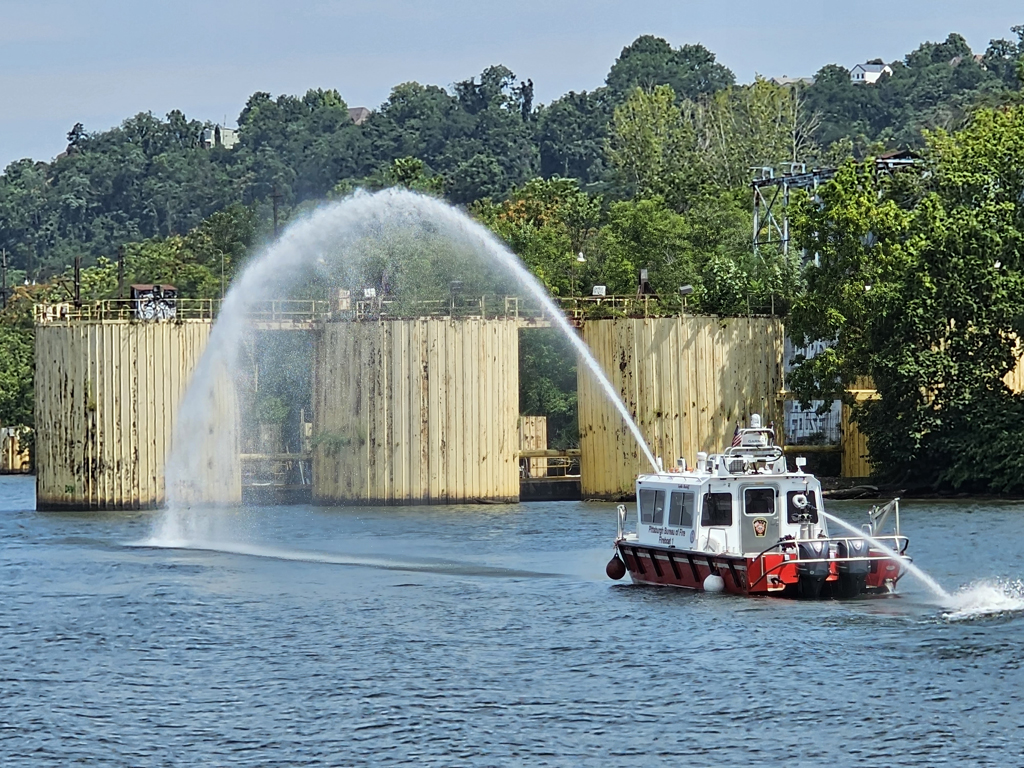

Pennsylvania seems to favour coloured bridges. In Pittsburgh they particularly like yellow. Our Segway Guide said the yellow represents Pittsburgh being the Golden Triangle. However, other sources suggest a different story. Yellow and black are the colours of the sports teams, hockey, football, soccer, and baseball, chosen originally from the coat of arms of William Pitt, after whom the city is named. There are a number of yellow bridges in Pittsburgh, and I have been noticing others painted blue, green, and silver elsewhere on the Ohio River. Dick tells me that only bridges older than 20 years can be painted. New ones are built of self-healing steel, which must be allowed to turn rusty and cannot be painted. I looked it up. The way it works, is small capsules filled with a healing agent are dispersed through the metal. When cracks happen, the capsules break and release the healing agent which then reacts with the metal and fills the crack, preventing it from spreading and limiting further damage.


Partway along the Allegheny River we passed the Heinz Factory. H.J.Heinz was founded in 1869. Their first product was ketchup. The slogan “57 Varieties” was introduced in 1896. At the time, Heinz did not have 57 varieties of anything, the founder just liked the idea and thought the number was appealing. Today, after a merger with Kraft, the Kraft Heinz company is the fifth largest food company in the world. The historic Heinz Lofts, that we could see from the river, is a complex of 11 buildings, including the unambiguously named Bean Building, Meat Building, and Cereal Building. Among other successes, Heinz pioneered safe and hygienic practices in the food processing industry, including innovations such as providing hot showers to employees, and weekly manicures for women who handled food products.

We were tied up in Fox Chapel by 2:30, although with 3 locks and a stop for a pump-out, it had been a long day. We had lots of help to tie up, and were glad to be assigned a slip and be somewhat protected from wakes. We did have to back out and reverse in, as again, the finger piers were too short for us to tie up bow-in. We rather stuck out into the fairway, but they are generously wide, and we didn’t seem to cause any problems.

In the evening we walked to Jimmy Wan’s, an Asian restaurant. After potstickers and spring rolls, we shared shrimp, chicken, and Singapore noodle dishes. The food was delicious, although not nearly as spicy as we would have preferred. The waitress told us that Americans don’t want even the spicy dishes to be very hot, which is interesting considering the popularity of hot chili, buffalo wings, and even some barbecue.
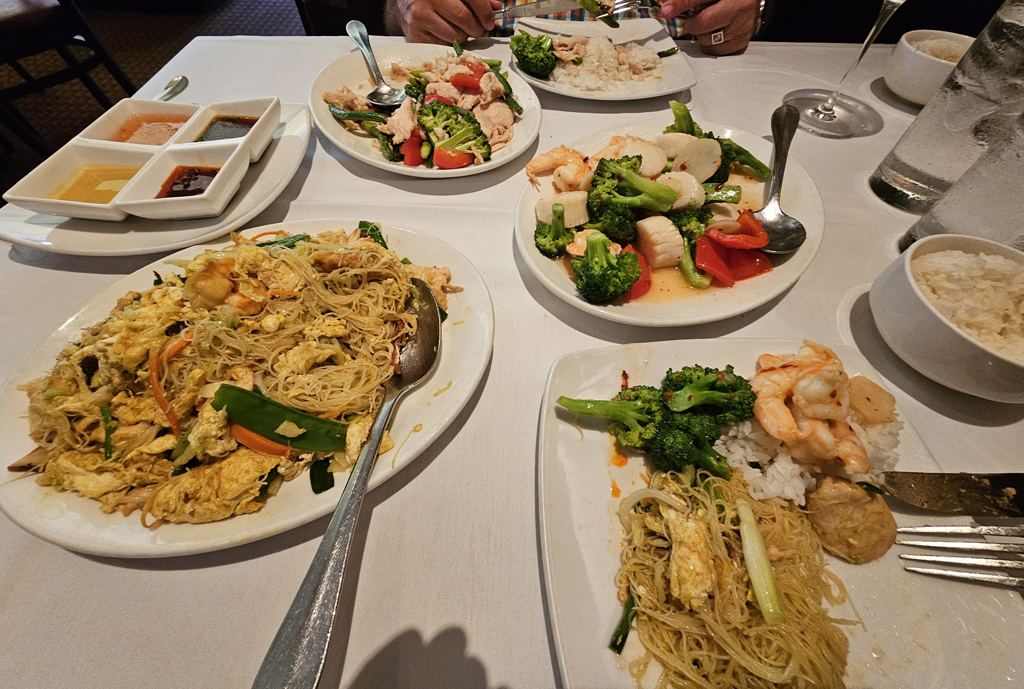
August 7 was a day for catching up, with a huge pile of laundry to be done. I made pizza (from scratch), and Dick was able to find bulbs at the chandler to replace the burnt-out light in my shower. He decided to do his at the same time. The pizza dough was a recipe I have had success with before, but I used a new method, and paired with my home-made pizza sauce that I brought from home, it was a very good one! Actually 3, with 1 ½ for the freezer.



The next day it was finally possible to put the registration and tax sticker onto the dinghy. Up to then we couldn’t reach it, but by backing into the slip, it put the dinghy right beside the dock. This makes us legal for about 2 weeks. The bill for the tax does not come from South Carolina until the end of the month. Dick pays it, and then they mail us new stickers – to Hilton Head Island of course! We would have to ask Kathy to send them somewhere that we expect to be for a few days, and that will accept deliveries and mail, and we would be counting on the vagaries of US Post Office. Then we would need access again to put the new sticker on. South Carolina used to issue tax stickers for 5 years, but now they do it annually.
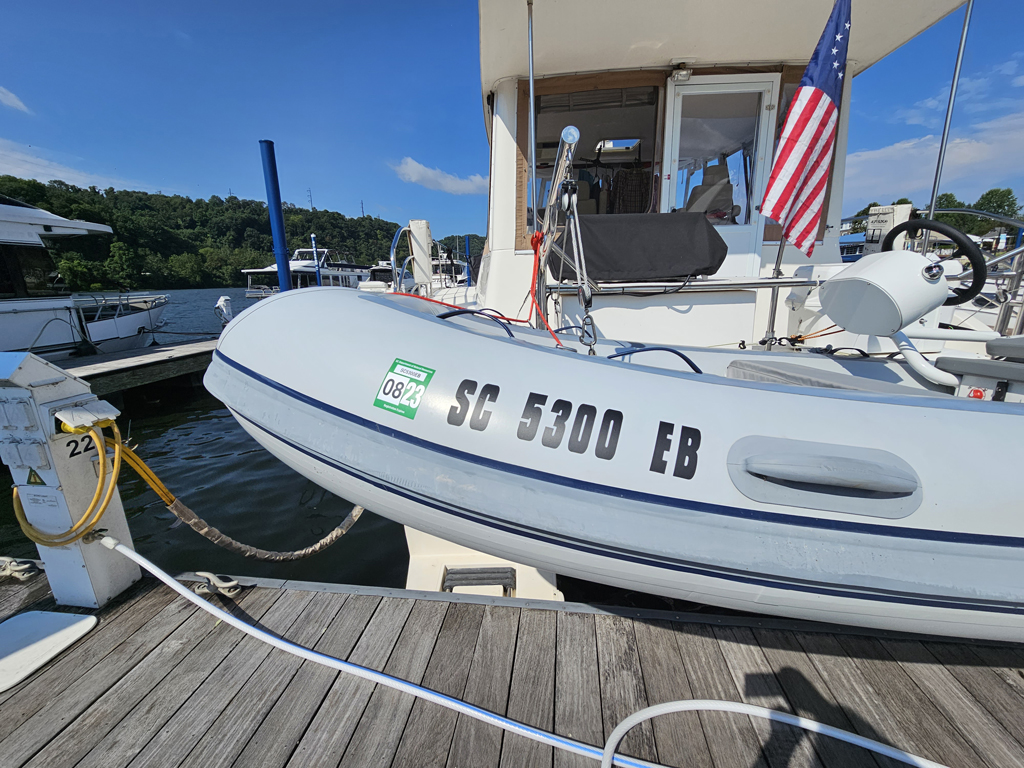

For some time (years in fact), we wondered about rusty water leaking out of an inlet on the back step. Last summer a fellow Endeavour owner solved the mystery, explaining that the rust came from a failed valve for direct connection to marina water. Dick had the valve fixed last winter, but Fox Chapel was the first place we stayed for a few days where the water was in a convenient place to hook up. It made a big difference, especially as laundry requires several fillings of the water tanks. We did notice when we arrived at our next stop, that some of the water in the tank is also being used, as they took a long time to fill. So, still something of a mystery as to how the direct connection works vis a vis the water tanks.

Dick changed the oil in the generator. This year so far, the generator has run more than the engines, because of all the “free” town walls and docks we have stayed at, plus the few anchorages. The savings from not having to pay a docking fee are somewhat used up when it’s hot and the generator has to run to provide power for cooking and especially air conditioning.
The day was cloudy and windy, but the clouds disappeared and the wind died down just in time for a long, uphill walk in the heat to the restaurant. It was quite good. Dick enjoyed his frito misto, but my trumpet mushrooms were too undercooked, so they were chewy and had little flavour. Dick’s branzino was good, and my mushroom bolognese was delicious. We were too full for dessert, although Dick had some gelato. Fortunately, the walk back to the boat was all downhill!




The lockkeeper on our return to Pittsburgh was an absolute pill. He chose to tell Dick off for contacting him on arrival at the lock by radio after he had spoken by phone, even though his instructions on the phone were ambiguous. He then proceeded to explain in detail how the lock is prepared and when the doors can open. We had different staff on the upbound trip, but also rude, opening only one side of the doors, and not responding at all to contact by phone or by radio. It is fascinating that the lockkeepers on each river seem to have a different culture. Those on the Ohio have been consistently professional and helpful, while those on the Monongahela, equally professional, were also friendly and chatty. Remembering previous rivers, polite and professional on the Mississippi, but abrupt and actually obstructive on the Illinois. In fact, we have read many accounts of Loopers having exceptionally long waits and rude treatment on the Illinois. Glad we won’t be visiting that particular river again!
We had hoped to arrange for delivery by truck for diesel while at Fox Chapel. Dick was initially given the name of one company, who said that as of this year they are no longer able to deliver fuel unless the boat is out of the water. This is a new Coast Guard rule, requiring a license, and for spill mitigation equipment to be carried on the tanker, and that supplier has chosen not to deal with it. After we were in the marina, Dick discovered that there is a company that has the license, and delivers, but because we were so late in calling, we could not get a delivery in time. This meant we had no choice but to get some diesel at the only marina in the area that has it. With a captive audience, they are charging $7/gal, more than we have ever paid anywhere. To add insult to injury, the docks are self-serve, as is the pump-out machine. Dick asked the lady in the office when he called, whether the pumps automatically shut off at a certain dollar amount, and was assured they do not. We tied up, started the diesel pumping, and began with the pump-out. When that was completed, we discovered that the diesel had shut off. Dick started it again, and at that point, a dockhand wandered down and asked if we needed any help. Yes, about half an hour ago! He stayed and chatted, probably hoping for a tip. None was forthcoming. Dick only put in enough fuel to get us back to Cincinnati, where we know there is an excellent, and attended, fuel dock.







On arrival at South Side, we discovered most of the long dock was covered in goose poop. We didn’t want to be too close to the pump-out machine, given the incompetent boaters that abound in these parts. Dick spent 45 minutes clearing about 100 feet of dock before we could get properly tied up and power connected. We would be there for 7 days. On approach, we passed the Fire Boat and got a toot- toot and a wave from Chip before he rushed off on Fire Boat business. Another pest on the docks at South Side is the incredible number of lantern bugs. These are a flying insect, an invasive species originating in China. They are everywhere, but fortunately are relatively easily squashed. They were first seen in 2014, and given the numbers we are seeing, they are increasing rapidly. Depending on the direction of the wind, Dick had to move debris and floating garbage away from Nine Lives as it gathered up against the docks. This, along with the goose poop and heavy wakes from tows and inconsiderate boaters, make South Side a less than pleasant marina to spend a week in.


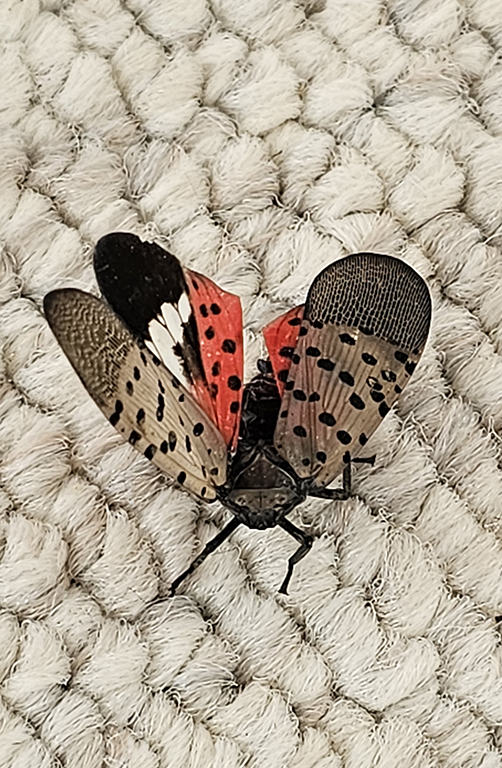
Dick collected the rental car. It was a pickup truck, not what he would have chosen, but better than the small city car that was the alternative.
Something over 30 years ago, I attended a conference in Pittsburgh, and ate in the glorious Grand Concourse, the former railway station. I enjoyed one of the best meals I had ever had. After listening to me talking about the experience for years, Dick earned himself some big brownie points by finding that it is still a fine dining restaurant, and making a reservation. I had been looking forward to this for weeks. The evening began poorly, as we were whisked through the stunning Grand Concourse, and shown to a middle table on a balcony. The maître d offered to try to find us a table in the main room, but Dick likes a cityscape, and basically didn’t want to bother. Then the evening deteriorated. We ordered our usual glass of something bubbly, and it took 15 minutes for the waitress to come and tell that they didn’t have what we had asked for. We waited another 15 minutes for the alternative. Starters were ordered, and eventually arrived, and Dick ordered a bottle of wine. Half an hour later, he was told they were out of that too. By this time, we thought it was too late for a whole bottle, so wine by the glass was ordered. The main courses eventually arrived, and were okay, but not exceptional. Altogether we were 2 ½ hours for a 3-course meal and 2 glasses of wine. The restaurant has been taken over by Landry’s, a chain we are familiar with from when we lived in Houston. They buy up successful restaurants in good locations, and subject them to corporate dumbing down and cost cutting. The food is generally good but essentially uninspired. The Landry’s in Hilton Head closed. Uninspired was exactly our experience, apart from ridiculous problems with the wine. We returned to Nine Lives long after dark, and had to pick our way around the goose and duck droppings as well as we could. Fortunately, most of the geese were at the end of the dock where Dick hadn’t cleared. There was lots of rain in the night, some heavy, but that stuff does not wash away.





August 10th was a quiet day. It was rainy, so Dick found it easy to resist the temptation to get on his bike and explore. Instead, he stayed in and worked on the print version of the blog. The dockmaster came and cleared the rest of the goose poop from the end of the dock. He then attached silver tape between pylons and electrical posts. In theory, this will discourage the ducks and geese from roosting there. Apparently, they have tried various solutions, some quite expensive. Large windsocks that shred, don’t make any difference. Strobe lights close to the dock were almost all broken, either by boats running into them, or by being kicked. The $3 rolls of shiny tape are the most effective, but I have to say they look very much like a police investigation is underway! After a few days of getting increasingly tattered, the tape also loses its effectiveness, and the geese are back roosting and making their mess.
Dinner at Paris 66 Bistro was a much better experience. It had a very authentic ambience, with an incredible aroma of garlic! The onion soup was a compromise between the cheese and bread laden American version, and the overly restrained version that one finds in France, that has only a couple of croutons and a grinding of cheese. Dick’s escargot were excellent. He also enjoyed his beef en daube. My trout meuniere, much admired by TripAdvisor reviewers, was good, but not at all what I had expected. I was looking forward to a trout filet, dredged in flour and pan friend in generous butter, served with lemon juice and parsley. Instead, the fish was poached in white wine and olive oil, and covered in chopped herbs with finely chopped capers. The dish is probably much enjoyed by American tastes that shy off butter, but it was quite different from what I had looked forward to (and it badly needed salt). Desserts were excellent – fruit tart for Dick and crepes flamed with grand marnier for me. The chefs resisted the temptation to dump a load of powdered sugar and whipped cream on my crepe, it was delicious!





From August 8 through 11, Nine Lives crew took the rented car to Canada, to Peterborough, Ontario, to attend a 90th birthday party for Dick’s Uncle George. It was great to see so many aunts, uncles, and cousins, and of course to spend time with Mum, Betty, and Ed. Friday evening, we returned to the great Indian restaurant that we discovered when we were on that part of the Loop. It was, if anything, even better. We did comment that of all our friends, only one couple would have enjoyed our extra spicy choices as much as we did!



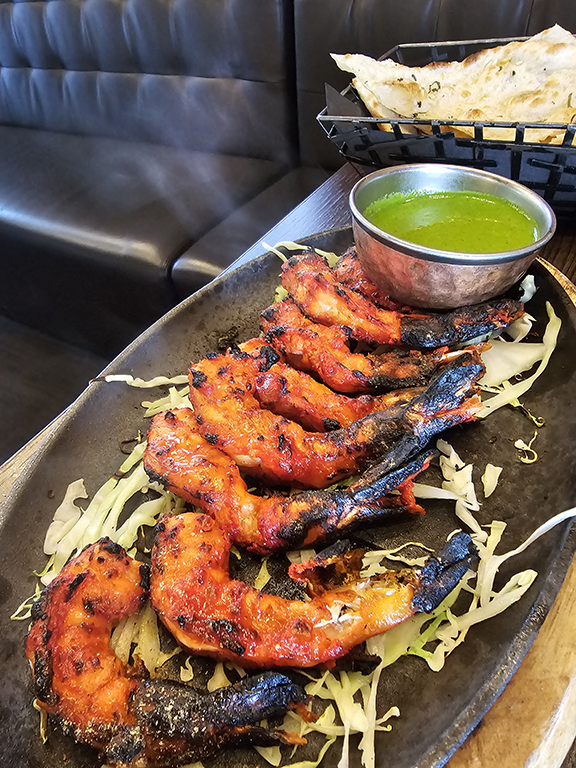


There was a bit of a delay at the border on our return drive, but we were back in Pittsburgh in plenty of time to get ready to go to Spirits and Tales. The son of good friends from Hilton Head is the chef. The restaurant is on the 10th floor of an upmarket hotel in the University, so we had wonderful views and interesting architecture to look at. We had an excellent meal. Dick started with a wedge salad, and I had a very good onion soup. Dick’s seafood fettuccini was delicious, and I enjoyed my perfectly cooked wagyu burger with truffle fries. We shared limoncello cake for dessert, also delicious, and, for a change, not excessively sweet.




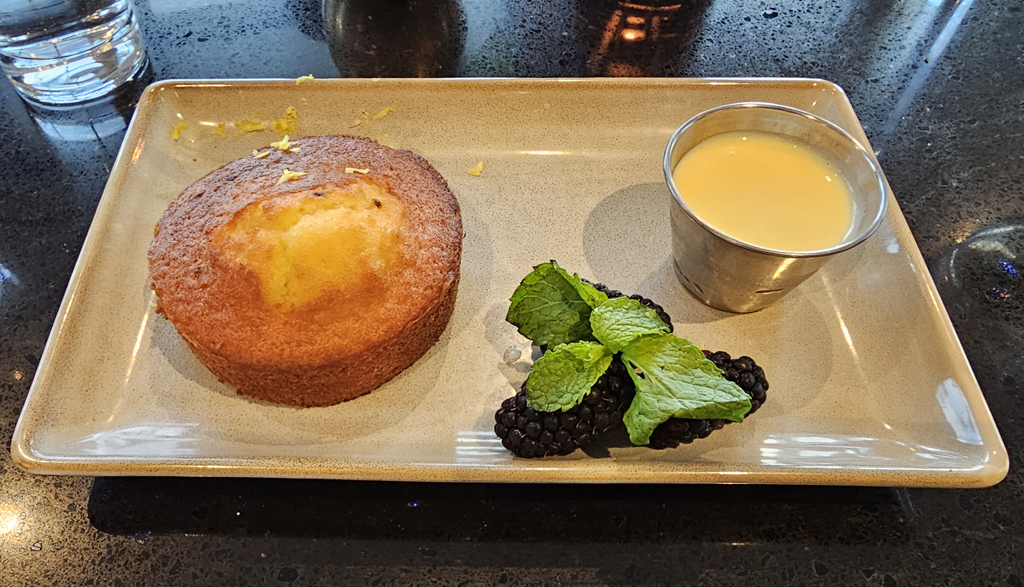
On our return to the docks, we were able to meet fellow Looper Jon, on Escapades, who is solo most of the time, but happened to be assisted for a few days by his sister. We enjoyed chatting and comparing notes.
Monday morning was our planned Segway Tour. There was the usual delay when the rest of the group, a family of 4, did not arrive 15 minutes early as requested, and then they had to disappear off to find a restroom before starting. It became clear during the 15 minutes of instruction and practice, that the boy (12 years old?), was not at all comfortable and was having a lot of difficulty getting used to the machine. The guide gave him extra time and help, and eventually we set off, crossed the bridge over the river, and the boy fell off. He was extremely lucky that he was just bruised. The fall could easily have happened in traffic crossing a road, or the machine could have landed on him and broken something. He and his dad walked back to the start, while the guide returned their Segways. Altogether, it was nearly an hour after the planned start before we set out again. It could have been a great tour, but it was quite rushed, with two hours condensed into one, and there was a bit too much riding on bumpy streets for my preference. We enjoyed it anyway, and got back to the boat before the rain started.



Pittsburgh is another American city that has reinvented itself since the dangerous days of the 1970’s. From a filthy industrial town that subsequently lost its tax base with the demise of the steel industry in the US, it has become a centre of excellence in education, medicine and invention. Across the river from our marina are a number of research laboratories, and everywhere we go there are new buildings and old ones being renovated. Older neighbourhoods are being gentrified. The park on The Point is a great downtown green space, as is much of the waterfront on the Allegheny. The Oakland area of the University is a glorious mix of historic and interesting new buildings.



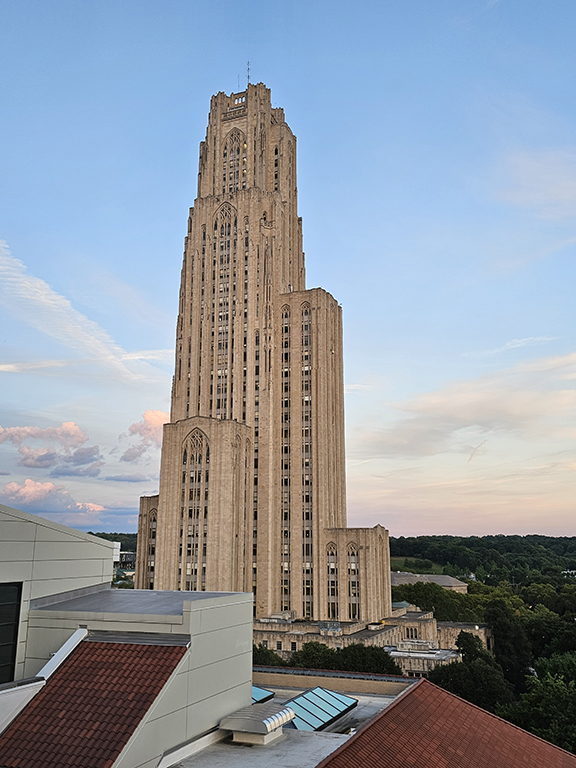

Reminders of the steel industry are everywhere. Not only in the form of derelict buildings (although those are mostly gone in the metropolitan area), but also artifacts have been preserved and incorporated into parks and squares. One of these is the gantry that was part of a water treatment facility that was built in the late 1970’s to support one of the steel mills. Before the water treatment plant was built, scale, a hot, oily byproduct of rolling steel, was dumped directly into the Monongahela River, on occasion raising the temperature of the river by as much as 40 degrees F. The tilting retort, or Bessemer converter, from the first blast furnace, started in 1859 and in use until 1927 is preserved in Station Square behind the musical fountain. Another memorial is a slag pot. Slag is the waste from iron and steel-making processes, shipped in huge pots by rail, and it can be used for roadbeds, landfill, concrete, fertilizer, and of all the unexpected uses, aquarium gravel. Steel from the blast furnace is poured into ingot molds, that are then moved to another part of the plant after solidifying. The ingots are removed from the mold and stored for future use. In time, they are reheated to soften them, and then rolled into slabs. The slabs are further processed into plate, sheet, and strip steel.





As it happens, in Dick’s long career with Dresser-Rand, when asked, we always say that the company makes machinery for the oil, gas, and petrochemical business. This is, of course, true, but I am reminded that Dick’s very first customers, when he was a new salesman, were steel companies. Riding his bike around Pittsburgh, seeing the artifacts and reading the accompanying plaques, was a real trip down memory lane for Dick.
Following an afternoon of heavy rain, we pulled out the umbrellas and set off the Eddy V’s. This is a fine dining chain (done right), with restaurants in many states. It was possibly the best meal we have had this trip. The lobster tacos to start, were completely different from anything we have had before, and were delicious. Dick’s rack of lamb was perfectly cooked, and my parmesan crusted sole was a treat. Lately we have been served asparagus that is well past its prime, yellow and bitter, but here we had a generous portion of beautiful green stalks, cooked just right and seasoned. We also shared an order of mashed potatoes with cheddar cheese and lobster, again a unique and delicious dish. Dick had berries with crème anglaise for dessert. I grumbled to the waiter that the problem with sharing-sized portions of dessert is that we don’t get to choose what we would really like. He asked what I would have had, and told me he would surprise me. A perfect small portion of the bananas foster cake dessert was delivered, and even set on fire at the table! When the bill came, it was described as “celebration” and there was no charge.





We were glad of the umbrellas as we waddled back to the boat after the big meal, skirting goose and duck poop. It rained all night. The next day was boat cleaning day. Nine Lives was vacuumed and dusted, bathrooms cleaned, and galley polished. Dick took advantage of the last day having a car and did a large grocery shop, visiting 3 different supermarkets and replenishing our stocks of heavy things like beer and fizzy water.

Later, we were delighted to host Nancy and Fred’s son Chris, the chef, and his lady, Kristen, for docktails. I had fun putting together a plate with some of the cheeses we brought from the Peterborough cheese shop, plus the Spanish cheeses we had on board. There were also various kinds of sausage, and some Iberico ham. We enjoyed the company very much, in fact I was having such a good time I forgot to take any pictures! We are hoping to meet them again next time they visit Hilton Head.
Better weather allowed Dick to get out on his bike for some exploration the next day. I worked on the blog while he rode on the Heritage Trail for several miles down the Monongahela. Later, he put his bike into the truck to return to the rental car company. He enjoyed riding back much more than the 3-mile walk he had to do to collect the vehicle.

In the evening, we walked up to the Hofbrauhaus. This is the same organization that owns the very famous Hofbrauhaus brewery, beer hall, and Octoberfest venue in Munich. The first brewery started in Bavaria in 1589. They began brewing Bavarian beer in Michigan in 1997, and opened their first brewhouse and beer hall in 2003 in Newport, Kentucky. Hofbrauhaus Pittsburgh opened in 2009. It is very authentic, with typical Bavarian food, a variety of beers, and all served at long tables with benches. I am sure there are lots of opportunities for songs and “Oans, zwoai, G’suffa!” That traditional Hofbrauhaus song was written in 1935, and was first performed by a Bavarian brass band at a sausage market. We met Valerie and Chip for a reunion and farewell get-together. We had a great time (although we did not feel any need to stand on benches and sing), and we all look forward to our next meeting.


















